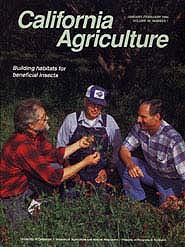


University of California
California Agriculture



|
|||
|
|||

Building habitats for beneficial insects
Cover:
Almond growers Glenn Anderson, left, and Ron Anderson, center, discuss the performance of cover crops with Merced County farm advisor Lonnie Hendricks Photo by Jack Kelley Clark
January-February 1995
Volume 49, Number 1 |
|||
|
University of California, 1301 S. 46th St., Bldg. 478 Richmond, CA
|